| Irish Forums Message Discussion :: List Of treasure Robbed From Ireland In the British Museum |
   | Irish Forums :: The Irish Message
Forums About Ireland and the Irish Community, For the Irish home and Abroad. Forums include- Irish Music, Irish History, The Irish Diaspora, Irish Culture, Irish Sports, Astrology, Mystic, Irish Ancestry, Genealogy, Irish Travel, Irish Reunited and Craic
|  
|
List Of treasure Robbed From Ireland In the British Museum


|
|
|
| Irish
Author |
List Of treasure Robbed From Ireland In the British Museum Sceala Irish Craic Forum Irish Message |
Finn

Location: Ireland
|
| Sceala Irish Craic Forum Discussion:
List Of treasure Robbed From Ireland In the British Museum
|
|
|
Sat Dec 11, 2004
I have lots of Ancient Irish art books and one consistent sadness in reading them is how often I read
On display in the British museum
The British empire just took them on behalf of the Royals (mafia boss) at the head of the system, same as they just took the jewels of India, Africa etc..etc..,
When I say 'they#, this mass systematic theft happened recent and more often long before folks alive today. no one is physically to blame now.
But land and resources that were stolen at the end of the cannon and gun are still in the hands of the thieves or descendants of thieves
The CAB, Criminal Assets Bureau should but will not likely ever investigate?
Because the theft was made legal by supposed laws? laws written by or on behalf of the thieves.
Ye could argue that many multinationals today effectively do similar. The British empire was in essence just a multi national franchise! all who bought in paying tax back to the franchise head, the mafia boss who in some lands call themselves royal families., but they are organized crime families what ever window dressing.
Unless folks know about the theft they will be ignorant of the wealth stolen and nothing will be corrected.
It is not about money, it is about our culture and our ancestors pride, and to not just accept that the theft of their work was ok.
How do folks think places like Buckingham palace were built?
when folks see the Villas of drug barons in Spain they know how they got the money.
But often When folks marvel at the beauty (which is to be seen fair enough in the architects skill) of Buckingham palace, they see glory and supposed culture!
imo, they should at the very least wonder how the feck did they get the money?
answer = theft
On display in the British museum
It always hits my stomach when I read that , I do not know if anyone has even made enough (or any) fuss about it
example
St Cuilean's bell circa 1100 AD
Bell Shrine of St. Cuileáin
A beautiful Gold Mass bell, which was originally enshrined with interlacing as well as human and animal heads damanscended with inlaid Silver strips and niello.
Found in a tree stump at Glankeen Co Tipperary
taken and put on display in the British museum, it is not their culture, it is not theirs, they should give it back.
british theft
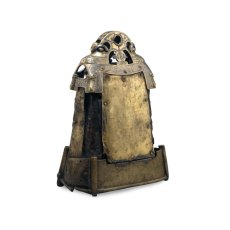
St Cuileáin's bell shrine
Irish, 7th or 8th (iron bell) and early 12th centuries AD
From Glankeen, County Tipperary, Ireland
A powerful lie detector
This magnificent bell-shrine is said to have been recovered from a tree at Kilcuilawn, and has survived rough treatment. The ancient iron hand bell inside was first used to call members of a monastic community to prayer. It comes from the ancient monastery of Glankeen founded by St Cuile�in in the seventh century. St Cuileáin was a powerful figure, the brother of Cormac, king-bishop of the rocky stronghold of Cashel nearby. It was venerated and later enshrined as a relic associated with him.
The iron bell is now incomplete. The elaborate outer brass case was added in the twelfth century. The case was cast in sections, some of which are missing. The front is now bare iron but once carried a Jewelled cross. The surviving main plate engraved with a cruciform pattern is the back. The elaborate openwork crest at the top is inlaid with copper and silver wires and further embellished with black niello and enamels. The intricate ornament is an Irish version of the Viking Ringerike style. It includes a typical looped knot on the front and a huge animal's head on each shoulder.
The early medieval custom of enshrining the belongings of the founders of churches and monasteries came to a second peak in Ireland under royal patronage in the twelfth century. As well as bells, items including staffs (such as the 'Kells crozier'), holy books, clothing, bones and teeth were cherished by later generations. Up to the nineteenth century the hereditary keepers of this bell, the B�arnan Cuile�in, used its power to detect false oaths; liars risked their heads being reversed.
Height: 30 cm (including shrine)
Width: 24 cm
M&ME 1854,7-14,6
Room 41, Sutton Hoo and early Medieval, case 28, no. 1
more british theft
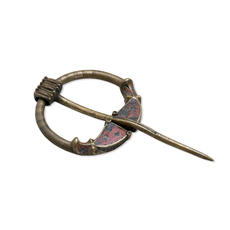
Penannular brooch
Irish, late 6th - early 7th century AD
From County Cavan, Ireland
Typical clothes fastener of early medieval Ireland
Both men and women of rank in Ireland wore brooches of this form: first the pin was stabbed through the folds of a cloak and then one end of the ring was pushed under the sharp end of the pin where it came out of the cloth. The ring was then turned until the pin tip lay securely locked in place beyond the raised bump of the decorated terminal.
This fine brooch has been cast in bronze and the pin and expanded ends of the ring are inlaid with bright red enamel. The addition of pieces of colorful millefiori glass is a distinctive feature of Irish jewelery at this period. The bronze collars show the smith experimenting with ways of fixing the glass when the enamel was heated. There is also simple stamped and incised decoration on the back. The front may have been tinned to give it a rich silver look.
The term 'penannular' is used for brooches like this which have a gap in their hoop. On eighth-century Irish brooches, like the Londesborough brooch, the terminals are enlarged and the space between is filled with added decoration but they still show that they have developed from this open-ring type.
Diameter: 7.3 cm
Length: 13 cm (pin)
M&ME 1856,3-20,1
Room 41, Sutton Hoo and early Medieval, case 26, no. 11
more british theft
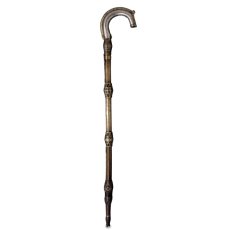
The Kells crozier
Ireland, late 9th-11th century AD
Irish religious relic found in London solicitor's office
This fine crozier was found without explanation in a solicitor's office in 1850, and was owned by Cardinal Wiseman before purchase by The British Museum in 1859. Originally it would have been venerated as a relic of a saint in the early church in Ireland, and also been a symbol of office for a leading cleric, possibly a bishop or abbot.
The appearance of the crozier today is the result of at least two periods of ornamentation as well as early attempts to dismantle or destroy it. The core is a staff of yew wood, now cut in two. This was first encased in bronze in the late ninth or tenth century when the staff was decorated with cast knobs (or �knops') and cross-shaped strips. Raised borders divide the knops into panels filled with animal interlace, once covered with bright silver foil. The original bronze casing to the curved crook had a diamond pattern grid and animal ornament.
In the eleventh century the crook was given an outer casing of silver sheet and a new crest in gilded openwork of linked birds. A new knop decorated with black niello and silver inlay in the Scandinavian Ringerike style replaced an earlier one at the top of the shaft. The straight end of the crook is a feature of early Irish croziers, and like many others it was altered to form a hollow box with a human head above, to hold a holy relic. On the underside of the crook a silver strip engraved in Irish asks for a prayer for C�duilig and Maelfinn�n who were involved in the refurbishment. Although these names have been identified with individuals who were important at the great Irish monastic city of Kells, County Meath, recent work has questioned this connection.
Enshrining items which had belonged to holy men or their communities was an important feature of religious life in early medieval Ireland. Many of these shrines, like St Cuile�n's bell, were preserved into modern times by the families of keepers who inherited this duty.
Length: 133 cm
M&ME 1859.2-21.1
Room 41, Sutton Hoo and early Medieval, case 29, no. 1
more british theft of Irish cultural treasures
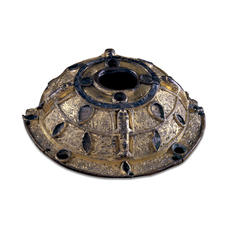
Shrine boss
Irish, AD 700-750
From Steeple Bumpstead, Essex, England
Reused as the handle-plate on the parish church
This once sumptuously decorated boss would originally have been attached to a shrine, along with four others, to form a cross-shape. It was apparently found in the church during construction work, stored in a chest and then attached to the chancel door where it was noted in 1842.
The boss was cast from a wax or lead form in bronze and then thickly gilded. The decoration is divided into bands of different ornament. Each band is divided into panels by a variety of twenty-four settings. These are now all empty but once held glass, crystal or amber giving the boss a rich glittering appearance. Four highly stylized lions crouch on the sides and divide the boss into quarters. At the top is a ring of black niello framing plain gold troughs once filled with panels of filigree. The ring surrounds a big hole where a large setting once lay. On the sides is a band of complex animal interlace while on the bands below and above there is trumpet and spiral decoration.
The accomplished decoration and casting is exceptional and is at the pinnacle of Irish art. In this respect it shares qualities with aristocratic pieces such as the Londesborough brooch, also in The British Museum. The battered state of this boss can only hint at what must have been a magnificent shrine and shows years of use as the backplate to a door handle.
Diameter: 13.5 cm
Gift of H. Oppenheimer
M&ME 1916,7-5,1
Department of Medieval and Modern Europe (study collection)
more british theft of Irish cultural treasures
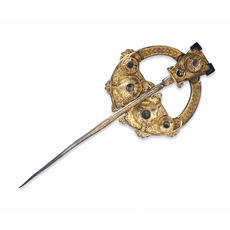
The Londesborough Brooch
Ireland, 8th- 9th century AD
Outstanding Irish brooch from Lord Londesborough's collection
This silver and gold brooch belongs to a 'Golden Age' in Irish art, which saw the production of the finest jewelery worn by people of rank and wealth. Evidence from sculpture and literature suggests that brooches like this one were used to fasten cloaks, and worn by both men, at the shoulder, and also by women on the breast.
The Londesborough brooch is unusual in that all its fine decoration is cast and no filigree was used. The three domed bosses look like miniature shrine fittings, which suggests that it may have been made for a senior churchman. Its original find spot is not known.
The brooch is a heavy silver ring cast with complex patterns of interlace, spirals, animal and bird motifs and then thickly gilded on the front. Seven circular amber settings on the hoop compliment the gold. The use of chip-carving, best seen on the panels of interlace, adds to the glittering surfaces. The pin was made from three pieces and the head is decorated in a style to match the hoop, with a large domed boss and amber at its center Two L-shaped fields at the top corners once held blue glass. The back of the brooch is also decorated with amber and has as well two inset gilt-bronze discs with Celtic triskeles.
The rich mixture of motifs on the Londesborough brooch is typical of the finest Irish work of the eighth century. It is known as the Insular style and combines Celtic, germanic and classical elements.
Alfred Denison, 1st Baron Londesborough, collected classical, medieval and Renaissance pieces in the 1850s and presented a notable collection of rings and brooches to his wife, including medieval Irish and Anglo-Saxon items.
Length: 24 cm (pin)
Diameter: 10.2 cm (hoop)
Weight: 201.5 g
M&ME 1888,7-19,101
Room 41, Sutton Hoo and early Medieval, case 27, no. 11
more british theft of Irish cultural treasures
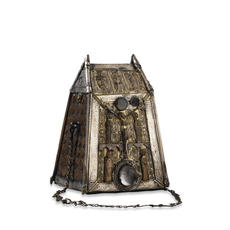
St Conall Cael's bell
Irish, 7th-9th century AD (bell), late 10th-11th century AD (brass mount)
From Inishkeel, County Donegal, Ireland
This iron hand bell is said to have originally belonged to St Conall Cael in the sixth century. Long after his death it was enshrined as a relic in an elaborate covering, and was worshiped by pilgrims visiting St Conall's well on the island of Inishkeel.
The bell is an early type made from a sheet of iron, its handle and loop for the clapper are missing. A plate of brass decorated with native Irish and Viking interlace ornament was added around the year 1000.
In the fifteenth century an ornate silver 'bell shrine' was made to protect and embellish the bell. This bell and its shrine, like most Irish reliquaries, were preserved by keepers who were the descendants of the stewards of monastic lands. Many like St Conall's bell were sold to collectors in the nineteenth century.
Relics associated with the early Irish saints were believed to hold miraculous powers and were much revered in the medieval church in Ireland. Oaths were sworn upon them and curses were cast using them. Water drank from ancient bells was believed to cure a wide variety of illnesses.
Height: 17 cm
Width: 12.8 cm
Gift of Sir A.W. Franks
M&ME 1889,9-2,22
Department of Medieval and Modern Europe (study collection)
more british theft of Irish cultural treasures
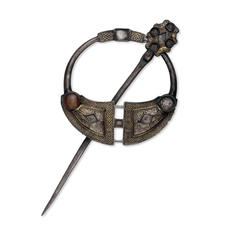
Silver ring brooch
Irish, 9th century AD
From Tara, County Meath, Ireland
Weighted to give a false impression of value
This handsome brooch is said to have come from the ancient royal site of Tara, County Meath, in Ireland. But all we know for certain is that came into the collection of Thomas Bateman, the pioneering Derbyshire archaeologist, in the nineteenth century.
The brooch was cast in silver before the addition of gilding and amber and there may once have been panels of gold filigree work in the three empty lozenges. There is no catch plate so in use the brooch works as a pin with a huge disc head. The form is typical of Irish jewelery in the eighth and ninth centuries.
The fine, repetitive interlace and style of the little animals in the central panels suggest a date in the ninth century, a period when Viking activity made silver and Baltic amber more abundant. Empty recesses on the back may have been filled with lead to falsify the weight (this is seen also on the great Londesborough brooch). The style shows the influence of contemporary continental animal art.
Diameter: 7.6 cm (hoop)
Length: 15.5 cm (pin)
From the collection of Thomas Bateman
M&ME 1893,6-18,29
Department of Medieval and Modern Europe (study collection)
more british theft of Irish cultural treasures
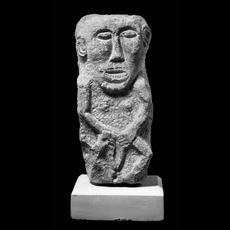
Sheela-na-Gig
11th-13th century AD
From Chloran, County Meath, Ireland
Sheela-na Gig is probably a corrupt version of the Irish meaning 'old hag of the breasts' or 'of the hunkers', referring to the figure's typical pose with bent legs. Over one hundred figures like this one have been recorded in Ireland and over forty in Britain. They are commonly set above doorways and arches, sometimes on castles but mostly on Christian churches and monastic buildings. The size, style and quality of carving are variable but the pose and display of genitalia unmistakable.
The ancient meaning or function of these figures is not well understood. They are usually interpreted as protective images, or as reminders of the grossness of lust. More benign subjects, placed in obscure corners, might have been intended to aid fertility. Their survival through centuries of reform and enlightenment is remarkable and suggests considerable local attachment to these powerful images for undocumented reasons. From the sixteenth century there are many records of destruction or orders to do so and several carvings have been reused as building material.
M&ME Witt 258
Department of Medieval and Modern Europe (study collection)
more british theft of Irish cultural treasures
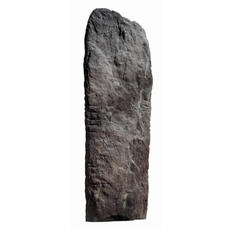
Sandstone memorial slab carved with Ogam script
Irish, 5th century AD
From Roovesmore Rath, Aglish, County Cork, Ireland
The earliest Irish writing
This rough sandstone slab is inscribed in ogam script along the vertical edges. It reads 'VEDACUNA [MAQI] TOBIRA MUCOI SOGINI', meaning '[stone] of Vedac, son of Tob of the Sogain' in Primitive Irish. It dates from the fifth century AD, before the widespread introduction of the Latin alphabet in Ireland. It is the earliest reference to the Sogain, a people known from later records.
The basic twenty-six ogam letters are formed by groups of lines and notches cut on a stem line. It is usually read upwards, but here it runs down one side and up the other. Ogam script was invented in southern Ireland around AD 400 and was used for simple inscriptions to record names and kin-groups in early Irish. Such stones marked boundaries and burials and are the earliest local records of the language and peoples of Ireland.
This stone, together with two other large ogam stones, comes from a rath or stone-walled homestead, in County Cork. They commemorate members of local groups of peoples also known from placename and early historic evidence. The stones had all been reused, perhaps in the ninth century, as roofing slabs for an underground chamber, suggesting that even at this early date these monuments had lost their meaning in the local landscape.
In 1865 the inscriptions were noticed and the stones removed by Colonel Augustus Lane Fox, later better known as the archaeologist General Pitt Rivers. He published a detailed account with drawings of his work.
Height: 2.1 m
Gift of Colonel Lane-Fox (later known as General Pitt-Rivers)
M&ME 1866,5-11,2
Great Court concourse, east side
more british theft of Irish cultural treasures
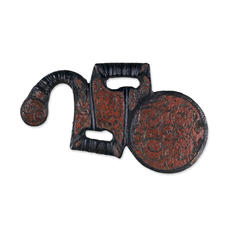
'Latchet' dress fastener
Irish, 6th-7th century AD
From Castle Island, Dowris, County Offaly, Ireland
Badge or brooch?
This strange shaped object was found in 1850. It consists of a large disc attached to a Z-shaped section, which forms two open slots, and terminates in a hook and smaller disc. Such pieces, incorrectly called 'latchets', were a form of dress fastener attached by coils of wire in the slots between the discs. They are only found in Ireland and remained popular only until the seventh century. They may have been worn in pairs.
Earlier latchets, some of which can be seen in the British Museum, have a more fluid open S-shaped body joined to the large disc. Some of these still have spring-like wire coils attached, and these may have been pushed through or sewn onto the fabric of a garment. The lavish use of red enamel and very finely worked spirals makes this an exceptionally fine piece and one that would have marked the importance of its owner.
Length: 7.4 cm
formerly 41/39/13
M&ME 1854,7-14,97
Department of Medieval and Modern Europe (study collection)
more british theft of Irish cultural treasures
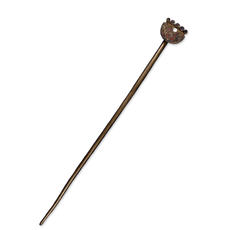
'Handpin'
Irish, 6th-7th century AD
From Craigywarren Bog, Skerry, County Antrim, Ireland
Long pin with a head resembling a hand
This decorative bronze pin is so big it would have been worn on a cloak. It is a fine example of a distinctive medieval Irish pin type. Handpins were in fashion from the fifth to the early seventh century. The name comes from the idea that the projecting tubes at the top are like fingers and the lower part resembles the palm of the hand. Here the palm has a curving pelta-based design set against brilliant red enamel. A herringbone pattern runs around the edge. The central hole held a cord used to twist round the tip of the pin to secure it when it was in use.
The bold use of red enamel is a special feature of Irish and British fine metalwork in the early middle ages. These pins were worn at the same time as big, enameled, open-ring brooches. Some are also known to have been made in west Scotland, which shared the same cultural traditions.
Length: 23.4 cm
Gift of Sir A.W. Franks
M&ME 1880,8-2,132
Room 41, Sutton Hoo and early Medieval, case 26, no. 22
more british theft of Irish cultural treasures
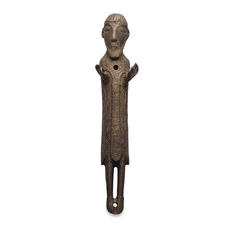
Bronze shrine figure
Irish, early 12th century AD
From Dublin, Ireland
Said to have been found on the site of the monastery of St John
Similar figures to this can be seen mounted on the twelfth-century shrine of St Manachan kept in Boher Catholic Church, near Clara, County Offaly. It is likely that this figure had the same purpose and was attached to a shrine by rivets through the holes piercing its breast and feet.
The bearded figure has been cast in bronze and depicts either an apostle or a saint. He is dressed in a bishop's robes, which are decorated with fine scrolled spirals, and geometric patterns. The arms project from the slender body and the hands hold a holy pose with the index finger and thumb touching.
Although the decorative detail on this figure is essentially Irish, the form of the figure shows the influence of Romanesque art from continental Europe. It reflects a period of contact overseas and local reform in the church in Ireland, when a regular pattern of bishoprics was established.
Height: 18 cm
Width: 4.3 cm
M&ME 1868,7-9,52
Department of Medieval and Modern Europe (study collection)
more british theft of Irish cultural treasures
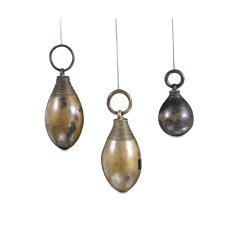
Three bronze rattle pendants
Bronze Age, 950-750 BC
From Dowris, Co. Offaly, Ireland
Rare 'musical' objects of the Bronze Age
These unusual objects are known as 'crotals' - globular or pear-shaped bells or rattles. They may have been rather heavy for suspension from straps, for example on horse harnesses, and instead may have hung from a rigid support, such as the draught-pole of a wagon. In this way the sound produced while in motion, while not very 'musical', would nevertheless draw attention to and enhance the procession of the wagon. As wagon accessories, crotals join other ornamental bronzes in embellishing wheeled vehicles in this period.
Crotals were cast hollow by flowing the molten metal around a clay core suspended within the mould. A small perforation was left in one side of each orb to allow the clay core to be scraped out, leaving behind only a small lump of bronze to serve as the rattle. The hole was then blocked with a metal plug. The initial casting also created a free-running ring at the top of each crotal for its suspension.
These three crotals were part of a large find of bronze metalwork made in Dowris bog in the mid-nineteenth century, which included weapons, tools and elaborate sheet metal vessels.
Height: 10.2 cm (min.)
Height: 17.2 cm (max.)
P&EE 1854 7-14 9, 13
Room 50, Later Bronze Age & Celtic Europe (gallery closed for refurbishment until 2007), case 3
more british theft of Irish cultural treasures
Most of the theft is not even given a mention of how it came abouts (they presumably knows it is regular 'plunder') but now and then
In 1865 the inscriptions were noticed and the stones removed by Colonel Augustus Lane Fox, later better known as the archaeologist General Pitt Rivers.
Alfred Denison, 1st Baron Londesborough, collected classical, medieval and Renaissance pieces in the 1850s and presented a notable collection of rings and brooches to his wife, including medieval Irish items.
This handsome brooch is said to have come from the ancient royal site of Tara, County Meath, in Ireland. But all we know for certain is that came into the collection of Thomas Bateman, the pioneering Derbyshire archaeologist, in the nineteenth century
n 1865 the inscriptions were noticed and the stones removed by Colonel Augustus Lane Fox, later better known as the archaeologist General Pitt Rivers.
and best of all
This fine crozier was found without explanation in a solicitor's office in 1850, and was owned by Cardinal Wiseman before purchase by The british Museum in 1859.
more british theft of Irish cultural treasures
And for those interested in pre antiquity of any kind
Note this is typical of the elaborated ignorance guesswork that ends up as a presentation of knowledge (presumably to portray some notion of credibility! )
These unusual objects are known as 'crotals' - globular or pear-shaped bells or rattles. They may have been rather heavy for suspension from straps, for example on horse harnesses, and instead may have hung from a rigid support, such as the draught-pole of a wagon. In this way the sound produced while in motion, while not very 'musical', would nevertheless draw attention to and enhance the procession of the wagon. As wagon accessories, crotals join other ornamental bronzes in embellishing wheeled vehicles in this period.
In other words
They do not know
But!! Ye can never sort of 'own the right' to something ye have no idea about 
All part of the 'image' of stolen goods presented in a museum as culture, and 'theirs' as well !
more british theft of Irish cultural treasures
Begrudgingly Ye have to sort of admire the sheer arrogance of it all. Stolen loot from around the world presented in the 'british museum.
Mind ye just like them british! If he had of gotten away with it all, by now we would of had the Al Capone memorial institute for fine art.
or Capones Regal Order Of Knights Superior
Or
CROOKS
At least they were honest easy to spot crooks though
more british theft of Irish cultural treasures
From a project by Mr John Sheehan
Department of Archeology and Prof Peter Woodman
Faculty of Arts, based out of UCC (university College Cork)
One of the largest antiquary collections was that amassed by William J. Knowles of Co. Antrim. Throughout his life he may have amassed and dispersed in various ways over 50,000 artifacts. This culminated in the sale of 30,000 items at Sotheby's in 1924. A large section of Knowles' collection was acquired by Alexander Keiller, who returned it to the National Museum of Ireland in 1938.
This collection which contained 15,000 objects has been cataloged with the help of The Heritage Council Keiller Knowles Project but this only forms the first stage in an effort to trace where much of Knowles' material ended up.
Barbed and Tanged Arrowhead From this collection we can reconstruct where many objects were first discovered and the types of landscape in which different prehistoric communities lived.
J. J. A. Worsaae
J.J.A. Worsaae Jens Jacob Asmussen, born March 14 1821 in Vejle (Denmark), died August 15 1885 at Copenhagen, was an archaeologist and a principal founder of prehistoric archaeology.
Introduction
Worsaae, under the commission of Christian VIII of Denmark, spent nine months travelling around Britain and Ireland during 1846 and 1847. One of the most famous Scandinavian antiquarians of the nineteenth century, he had spent time visiting Sweden, Austria, Germany and Switzerland during the preceding years. The terms of his royal commission, as they related to his tour of Britain and Ireland, primarily focused on an investigation of the Viking-age antiquities and monuments of Scandinavian character.
During his stay in Dublin Worsaae appears to have visited the location in the Kilmainham-Islandbridge area where an important series of Viking graves had recently been discovered. He obtained a number of artifacts from this site, some through the offices of the Royal Irish Academy, and also amassed a collection of antiquities from elsewhere in Ireland through his connections with dealers such as James Henry Underwood, of Dublin, and Whyte Baker, of Callan, county Kilkenny. These artifacts were sent by Worsaae to the Museum of Northern Antiquities, Copenhagen (now the National Museum of Denmark), where they remain. In addition, he arranged for James Plunket to prepare a series of watercolours of artifacts in the collections of the Royal Irish Academy. It is these watercolours, which are also housed in the National Museum of Denmark, which form the basis of this research project.
The Worsaae Watercolours
These consist of a collection of twelve large drawings,each measuring c.67cm by c.100 cm, and numbered I to XII. On the lower margin of each in written: 'Presented to the Royal Museum of Northern Antiquities of Copenhagen by the Royal Irish Academy. Dublin 11th January 1847. E. Clibborn, Curator of Museum.' In general, the items depicted in the watercolours are arranged by type and period. For instance, no. II consists mainly of Bronze Age weapons, no. IX consists exclusively of Bronze Age gold ornaments and no. X consists of a mixture of Early Medieval and Viking-age silver objects. The objects are drawn to full scale with great attention to detail and are beautifully coloured.
Aside from their artistic value, the Worsaae watercolours are important because they evidence some of what the Royal Irish Academy's collection of Irish antiquities contained in the mid-nineteenth century. There are few registers in existence from this time and little is on record concerning these early finds in the known antiquarian sources. More importantly, there are annotations concerning the find-provenances of some of the artifacts added to some of the drawings. These will enable previously unprovenanced objects in the national collections to be identified and provenanced.
more british theft of Irish cultural treasures
Yes it is obvious they are so very particular, so the british museum are 
Those who might live over there and 'fall for that type of self promotion' and the gullible around the world who fall for the 'antiquity of 'british and it not being a plundering franchize
The facts don't!
What folks want to remember most is the idea (let alone actual) of a race called 'british' never even existed until the 18th century! And yet the british museum uses words to justify many of these and many other pieces! from pre history 
Like McDonalds taking credit for the cow
Words like typical British art or similar british finds
Amazing how unparticular they can be!
British or Britain never even existed when any of these works were made by natives of Ireland in the landmass that is surrounded by water.
Theft it is! just not common (as in this is very elaborate) theft!
Let's see if we can start something positive, a wrong put right.
When ye get a moment try and find any Irish exhibit the British museum has and post it here.
If we can get this list up and show how much has been stolen I will post it to every Irish newspaper and start A fuss that the Irish Government could not apparently give a shite about starting.
OUR ANCESTORS CULTURE.
Not british or English,
Our Island of Ireland Irish culture!
we want it back
Well now the sad thing is the loot is among such vast stores that ye would not know what they had.
I believe the figure is for every exhibit on display in the british museum they have well the words were of one frustrated curator 'several hundred' just sitting in dark cellars with no room for display on a permanent basis.(many are never seen)
So that is not just theft it is immoral! and a disgrace to human culture.
In the Irish case, our art and cultural items.
These were not stolen from Irish museums, these were stolen from the soil, churches, buildings and from Irish people throughout the past several hundred years.
Now of course there is a fine line between where do ye start and end, do we likewise give Dublin castle back to the British, (not that the british built it as they as a system never even existed then) and other castles because they were Norman built (often on Irish backs of slavery), well that is not gonna be easy as it is a building! besides if so they would have to give them back to the French who conquered their land and were the Norse men normans.
No its not as foolish a plan as that, it is about fairness, items that can be easily handed back to their rightful place of origin.
art, jewels, books and such
For instance an ancient glass object made in Ireland belongs in Ireland.
I am all for Ireland giving objects back (and she has many, by default of Irish involved in colonial exploits, exploits as in exploitation) as well; we have no right to aboriginal or African artifacts, without consent of the maker. If the maker cannot be ascertained! then the people by default of their government must say it is ok for us to display the act of theft and not just display it but as in the british museum case imply that it is british culture.
Not so much proud of theft and claim it as their own, as the lies and myths run so deep as they now believe the fantasy themselves and see no wrong in it.
But curiously they do when the Nazi system did the same with the treasures of lands they invaded and brutalized, that is somehow different.
If ye took the foreign made exhibits out of the british museum it would not be empty as there are plenty of ancient and cultural artifacts for show, the people of that land would also then be able to understand their own true cultures.
Not a mythical one that claims glory upon the force theft of others cultures.
grate britain Laughing The notion is so perverse as to be almost sick!
Great at what?
copying the Romans and other Imperial cultures, adapting their brutality and law making to enforce humans to conform and sponge off their toils.
wow what an achievement for humanity that copying was! truly deserving of great
Maybe they mean great as in how the system thought up new plans,
like them and the Portuguese that transported maybe a hundred million African salves to the Americas (ye know before they got all coy and anti the practice- ye know after!! they made the equivalent of BILLIONS of pounds in todays money- where the feck do folks think the windsors got the money for such a palace!!)
Or the Concentration camps of Africa (Boer war being a classic example) where they showed nearly half a century before the German Nazi system how to cope with a populace.
illustrating for future ones how to build empires, was that great, or was it the effective acts of drug dealers or mafia thugs but dressed up in silks!
if the vermacht had of won
do folks think that they would be called 'average Germany'
The british system entitled itself that word great and did so by using the exact same methods the Germanic cousins in another royal parasitical system (that by then had like wise amalgamated many cultures into a new one- a franchise) tried to copy.
Hitler can be seen as a Cromwell, a product of a system that saw other human beings out of Germany as less.
Sir Bob Geldof of the Commission for Africa - The commission is not dealing with that, that's the first thing. For me it's not important. I'm Irish, there's a lot of Irish treasures in England. I don't care they can stay in England. I think they should stay in England. I think the Ethiopian thing should be in England. I think the Greek thing should be in England. That's history. Millions and millions of people see them in England. Millions of people can come here and see the beautiful things you've got. I don't think it's an important issue. I mean I understand that some Ethiopians do, but it actually it distracts from real issues, like education, hunger and that. It's not very important. Millions of people still see these things. I understand that people feel it's a part of their country, but in all the world, throughout all history, there are beautiful objects of humanity that were produced by many cultures, and they move around the world and we're all human and we can all appreciate that common humanity that made these beautiful works of art, but to me it's not important
Pretty clear why he got a knighthood, every country deserves to be fed but England deserves the right to show off art theft on behalf of the world.
not only is he a pretender who has made millions on the back of so called hunger (he was a one hit wonder before that) he is a shameless pretender as well.
just read that pompous and pretentious shites words! as if he gives a feck about Africa apart from when his work slips and he needs some more tv time.
Around 44 MILLION this charity worker is worth
and folks without a penny to rub fall for it! and put their hand in their pockets to pretend it changes a thing out in Africa that is still being raped by the West and especially Britain.
The British Govt giving back the billions, the governments before them stole from Africa might help though!
but ye wont hear him utter a word against his beloved 'true ' home
he is not Irish just coz he was born here. as he proves by the above remarks about our treasures.
We have no hunger slur bob so do not use analogy to lend weight to another one that is not relevant!
This is the sort of shite the Irish Government does, when it has the so called right to own
August 11, 2002
Armada booty surfaces in Derry
John Lee
ARTEFACTS recovered from part of the Spanish Armada that sank off the coast of Donegal more than four centuries ago have found a new home. The treasures, estimated to be worth �3m, are to be displayed in the Tower Museum�s O�Doherty Fort in Derry.
Twelve ornate Spanish and Flemish cannons � worth at least �47,000 each � muskets, body armour, garments, linen, provision vessels and navigation instruments are among the memorabilia that will appear in the exhibition when it opens next year.
The galleon from which the treasures were retrieved in the 1970s is regarded as the most important find off Ireland to date, but its contents have languished in back rooms of the British Museum and Ulster Museum until now.
The ship, La Trinidad Valencera, was part of a 122- strong squadron sent by King Philip II of Spain in the summer of 1588 to invade Elizabethan England.
However, his plans foundered as the vessels were forced to flee via Ireland when they met opposition from Sir Francis Drake.
Off the Irish coast they were buffeted by a violent storm and 23 ships sank.
Although much of the contents of La Trinidad � the second largest vessel in the fleet � survived, its 330 sailors were not so lucky. After arriving ashore, they were met by a British garrison and were asked to lay down their weapons in return for repatriation. Having surrendered, they were stripped and put to the sword.
At the entrance to Kinnagoe Bay, a plaque indicates the location of each of the vessels dotted along the western seaboard, from Co Kerry to Co Donegal.
La Trinidad Valencera lay undiscovered close to the bay on the Donegal coast until divers from the City of Derry Sub-Aqua Club happened across it. The wreck was just 100 yards offshore.
Its contents were raised from the seabed in 1975 with the help of Professor Colin Martin of St Andrews University and the BBC, which made a documentary of the event.
Because the ship lay in Irish territorial waters, however, the items were given to the republic�s government which then sold them for a nominal fee. The collection was believed to be bound for a British museum but in fact remained in boxes, all but forgotten until last month. These and other Armada treasures owned by British and Spanish museums as well as private collectors will be displayed at the Derry venue.
Dermot Francis, who has been raising money over several years to bring the collection together, said: �La Trinidad Valencera was the second largest vessel in the Spanish Armada. It was carrying huge siege guns and a lot of ordnance equipment which gives a great insight into the Spaniards� intentions. They wanted to conquer and colonise.
Kevin Baird of the Northern Irish National Lottery, which last month handed over �2.4m (�1.5m) to enable the exhibition to go ahead, said: �We are going to have the largest Armada exhibition in the world. It has been sitting in boxes and hadn not got a place where people could come out to see it and enjoy it. That�s what the Tower Museum is now going to provide.�
Fair enough that should be in Spain, let them worry about it, but it shows how this so called Irish government care. I don't recall them asking the Irish nation, could they sell it! maybe it paid for berties jet.
This is the beauty of the internet folks, lets make a fuss, show them up, encourage other countries to get their stolen treasures back as well.
They call it the British museum! and a fine museum it is!, But it is crammed full of antiquity that has nothing what so ever to do with with the land of Britain bar common theft.
Whilst it is likely no ones fault alive today, that does not need to be the end of it and say that is just history.
It is not moral, ethical or reasonable that any Irish treasure taken from Ireland whilst it was under occupation by force of arms is still in improper hands.
The Irish Government should insist that our ancestors art treasures are handed back.
|
|
|
|
|
|
|
|
|
|





















